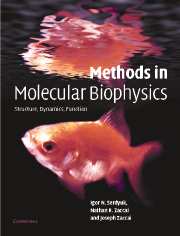Book contents
- Frontmatter
- Contents
- Foreword by D. M. Engelman
- Foreword by Pierre Joliot
- Preface
- Introduction: Molecular biophysics at the beginning of the twenty-first century: from ensemble measurements to single-molecule detection
- Part A Biological macromolecules and physical tools
- Part B Mass spectrometry
- Part C Thermodynamics
- Part D Hydrodynamics
- Chapter D1 Biological macromolecules as hydrodynamic particles
- Chapter D2 Fundamental theory
- Chapter D3 Macromolecular diffusion
- Chapter D4 Analytical ultracentrifugation
- Chapter D5 Electrophoresis
- Chapter D6 Electric birefringence
- Chapter D7 Flow birefringence
- Chapter D8 Fluorescence depolarisation
- Chapter D9 Viscosity
- Chapter D10 Dynamic light scattering
- Chapter D11 Fluorescence correlation spectroscopy
- Part E Optical spectroscopy
- Part F Optical microscopy
- Part G X-ray and neutron diffraction
- Part H Electron diffraction
- Part I Molecular dynamics
- Part J Nuclear magnetic resonance
- References
- Index of eminent scientists
- Subject Index
- References
Chapter D1 - Biological macromolecules as hydrodynamic particles
from Part D - Hydrodynamics
Published online by Cambridge University Press: 05 November 2012
- Frontmatter
- Contents
- Foreword by D. M. Engelman
- Foreword by Pierre Joliot
- Preface
- Introduction: Molecular biophysics at the beginning of the twenty-first century: from ensemble measurements to single-molecule detection
- Part A Biological macromolecules and physical tools
- Part B Mass spectrometry
- Part C Thermodynamics
- Part D Hydrodynamics
- Chapter D1 Biological macromolecules as hydrodynamic particles
- Chapter D2 Fundamental theory
- Chapter D3 Macromolecular diffusion
- Chapter D4 Analytical ultracentrifugation
- Chapter D5 Electrophoresis
- Chapter D6 Electric birefringence
- Chapter D7 Flow birefringence
- Chapter D8 Fluorescence depolarisation
- Chapter D9 Viscosity
- Chapter D10 Dynamic light scattering
- Chapter D11 Fluorescence correlation spectroscopy
- Part E Optical spectroscopy
- Part F Optical microscopy
- Part G X-ray and neutron diffraction
- Part H Electron diffraction
- Part I Molecular dynamics
- Part J Nuclear magnetic resonance
- References
- Index of eminent scientists
- Subject Index
- References
Summary
History and introduction to bioliogical problems
Traditionally, hydrodynamics deals with the behaviour of bodies in fluids and, in particular, with phenomena in which a force acts on a particle in a viscous solution. Very eminent scientists, such as Isaac Newton, James Clerk Maxwell, Lord Rayleigh (J. W. Strutt) and Albert Einstein, started their careers with major contributions to the science of hydrodynamics. Note that not only are the discoveries from more than 100 years ago still highly relevant today, but also that they continue to stimulate important new developments in the field.
1731
The science of hydrodynamics arose from the classical book Hydrodynamics by Daniel Bernoulli, which contained the ‘Bernoulli law’ relating pressure and velocity in an incompressible fluid, as well as a number of its consequences. The next fundamental contribution to the field was in 1879 when Sir Horace Lamb published another classical book also named Hydrodynamics.
1821
Botanist Robert Brown described the random, thermal motions of small plant particles suspended in water, a phenomenon that was later named Brownian motion. In 1855 Adolf E. Fick published a phenomenological description of translational diffusion and deduced the fundamental laws governing transport phenomena in solutions. In the 1990s, the method of video-enhanced microscopy was proposed for the direct observation of Brownian motion of labelled macromolecules in a membrane.
1846
J. L. M. Poiseuille produced a theory of liquid flow in a capillary. Based on this theory, Wilhelm Ostwald invented the viscometer and introduced its use in physical and chemical experiments.
- Type
- Chapter
- Information
- Methods in Molecular BiophysicsStructure, Dynamics, Function, pp. 251 - 267Publisher: Cambridge University PressPrint publication year: 2007



